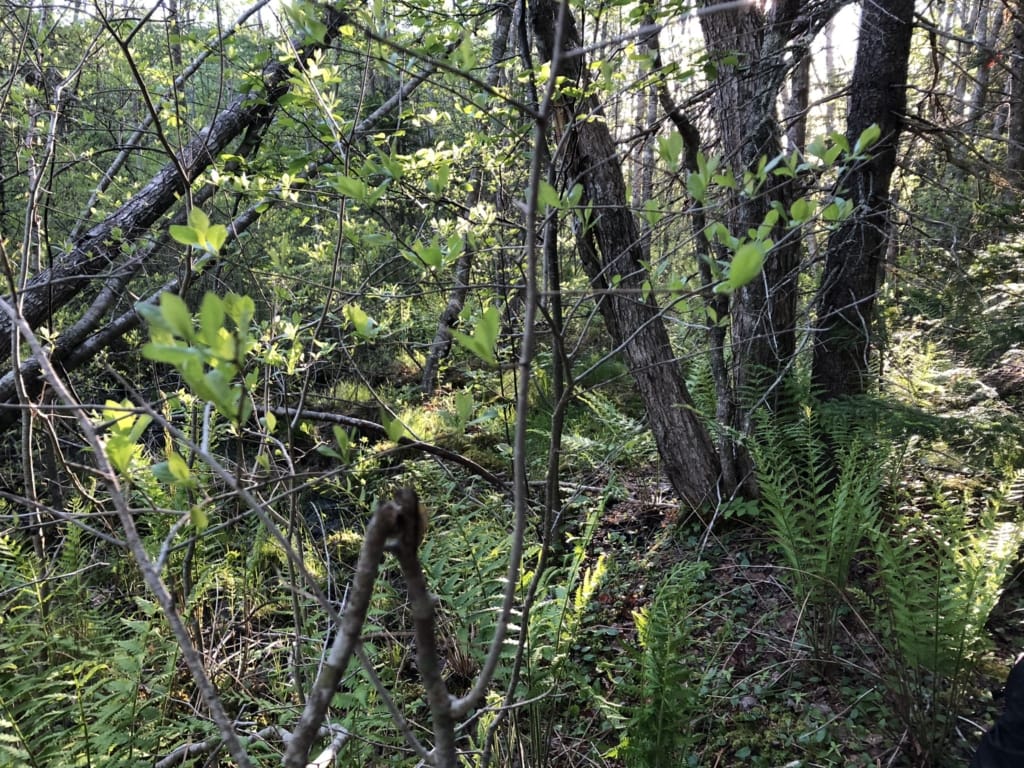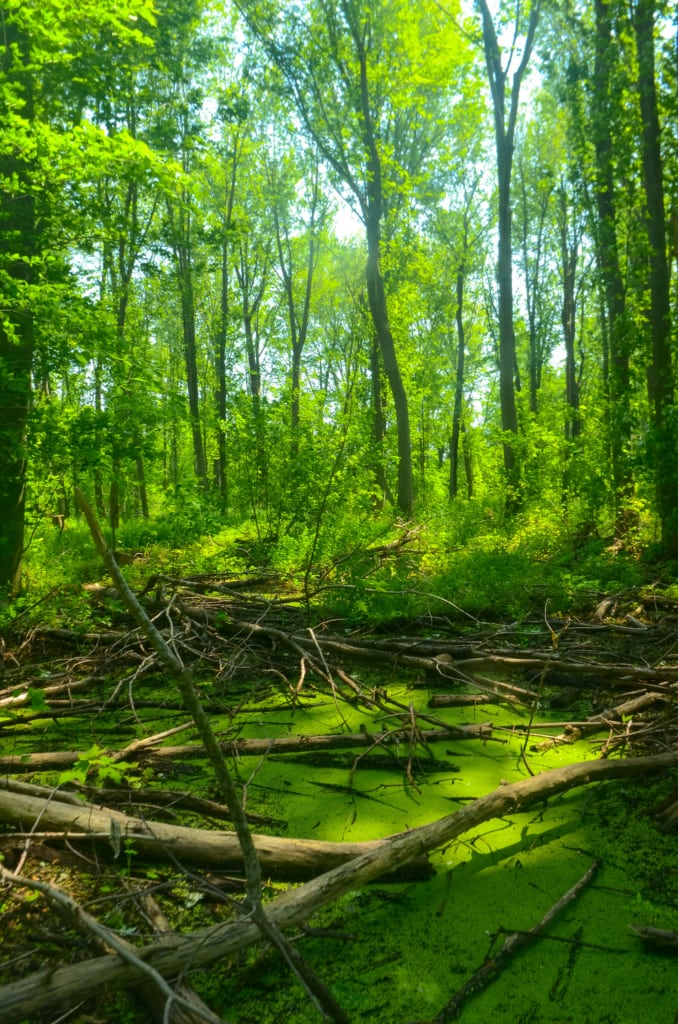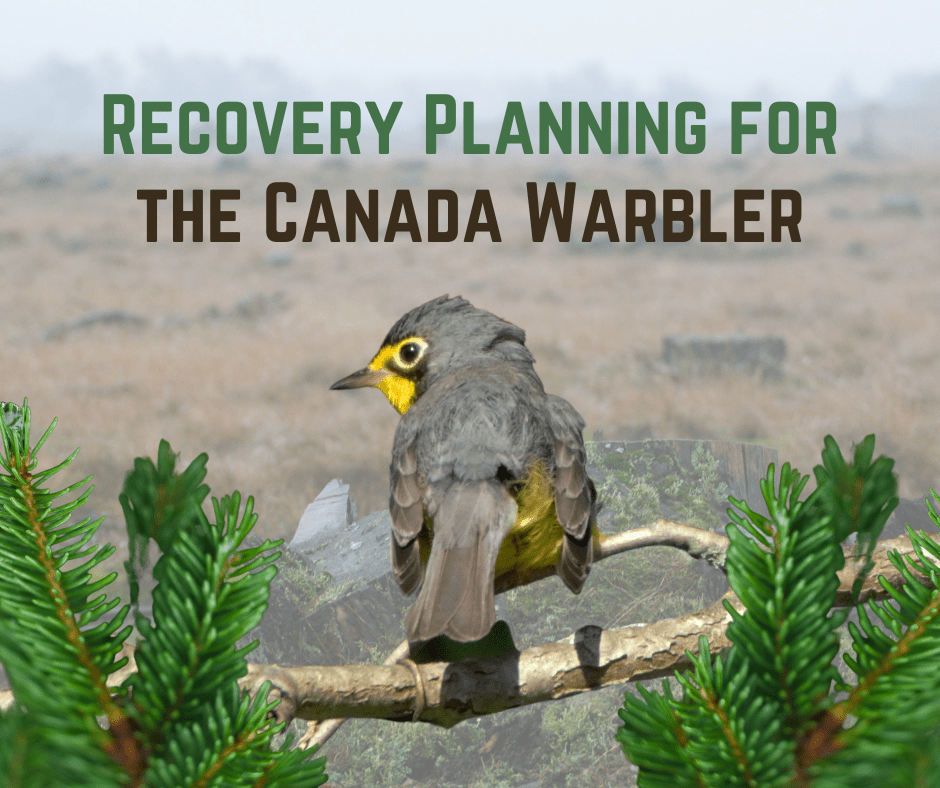A Bird Flies Into a Court Room…
The Canada Warbler is a small forest-dwelling songbird that winters in Central and South America and breeds in Eastern and Central North America, from Alberta to Nova Scotia. They are one of our last migratory birds to arrive in the summer and among the first to leave after breeding, preferring the warm buggy weather of true summer. Throughout its short stay in the North, the Canada Warbler makes use of mixed deciduous/coniferous forests with a dense shrub and complex understory layer. In Atlantic Canada, it seems to prefer forested wetlands, mature cedar swamps, regenerating mixed forests, and moist sites with cinnamon fern, speckled alder, and sphagnum.

The species was designated as Threatened under the federal Species At Risk Act in 2008, reassessed as Special Concern in 2020, and listed as Endangered under the provincial Endangered Species Act in 2013. Being listed as Endangered or Threatened in Nova Scotia requires the province to appoint a Recovery Team of species experts, produce a Status Report examining the state of the population, and publish a Recovery Plan guiding actions for the species’ recovery.
The Canada Warbler is also one of the 6 Species At Risk featured in the Bancroft vs NS Lands and Forestry judicial review you helped our nature network prepare for over 2019-2020. At the time we went to court, more than 60 species were listed as Endangered, Threatened, or Vulnerable in Nova Scotia, but only half had completed reports and plans available. Endangered Species should receive a Recovery Plan within one year of listing. It took the province 7 years (6 years late according to legislation) to deliver on its legal responsibilities to the Canada Warbler, by the time the Department adopted the federal Recovery Plan for the Canada Warbler (which is an option under the ESA) in late 2021.
Knowledge Gaps and Jurisdictional Boundaries Prevent Meaningful Action
Researchers have demonstrated a consistent and concerning decline in populations across Canada Warbler’s North American breeding range, but there are significant gaps in the boreal forest and other understudied areas. Similarly, though threats are thought to include factors related to land conversion (draining forested wetlands, forest harvesting, energy and mining, housing development), reduced insect prey (pesticides, wetland loss), and accidents/predation (window collisions, roaming cats), it is not well understood how these threats may differ across the birds’ range. As a result, there is not enough information available to inform an assessment of the critical habitat necessary for the survival and recovery of the species, which is a requirement under law.
So what do we know? Well, in good news, we think some populations may be starting to rebound. Canada Warbler numbers, overall, may be slowly increasing as different jurisdictions across the country address local threats. Breeding Bird Survey analyses completed by Environment Canada suggest an annual population decline across Canada of 2.9% per year between 1970-2012, or ~71% total decline in that time, but data collected since 2012 seem to suggest a 41% increase over the last decade. Locally, things might not be so positive. Canada Warblers seem to have declined in Nova Scotia to a greater degree than in other jurisdictions and the Maritimes Breeding Bird Atlas, which profiles the state of birds in Nova Scotia, New Brunswick, and Prince Edward Island, found significant declines between both 1986-1990 and 2006-2010.
We also know a bit about the birds’ habitat preferences, apparently preferring little wetlands or clearings inside big forests that avoid dramatic changes over time. Previous work has suggested that Canada Warblers may prefer “edge” habitats, making use of small wetlands and regenerating stands at the edges of development, but more recent research seems to suggest that these are not ideal breeding grounds, simply foraging and transitory habitats. Though breeding territories may range from only 1-3ha, research has shown that bird densities decline within a few kilometres of agricultural and human development, indicating possible competition for prime territory in pristine habitats. We also know that Canada Warblers show extreme site fidelity, returning to the same spot each year to breed, possibly increasing competition when birds return to places experiencing significant habitat change.

Understory Management, Those Darn Deer, and Long-term Insect Declines
Despite hopeful findings in other parts of the country, Canada Warblers still face many threats in the Maritimes. A dense shrub layer is an important feature of Canada Warbler habitat across its range. In Atlantic Canada, natural gap creation processes like wind-throw and insect outbreaks may have once been major drivers of warbler habitat availability. Now, urban development and industrial-scale silvicultural practices like selective cutting and clearcutting, combined with herbicide use and the suppression of natural disturbance regimes, may prevent the shrubby regeneration needed by breeding pairs.
Deer browsing may create another threat. In areas where deer numbers are high, over-browsing of deciduous shrubs can dramatically change the lower stories of the forest resulting in reduced habitat for bird species like the Canada Warbler. In fact, this has been demonstrated in birds with similar habitat requirements, such as the Kentucky Warbler, in Central Canada. Canada Warblers, like the moose and caribou before them, may be feeling the lingering effect of a deer invasion that started causing problems for native species as early as the late 1800s.
On top of these habitat-related threats, Canada Warblers and many other aerial insectivores have had to contend with declining insect populations across the Northeast for years. Insect declines are poorly understood, but are thought to be related to historic pesticide use and disappearing wet habitats.
Canada Warblers are also thought to be particularly susceptible to collisions with buildings and other infrastructure, being night-time migrants and residing in low shrubby areas during the day. Along their migration route, where birds may temporarily reside in parks and other urban green spaces, birds are also at risk of predation by roaming cats.

Voluntary Stewardship vs Regulation
So now what? By accepting the federal Recovery Plan, the province has technically fulfilled most of its legal obligations under the Endangered Species Act. However, this doesn’t necessarily translate into meaningful conservation for the Canada Warbler. The federal plan provides minimal guidance for actions that could be taken in Nova Scotia. Moreover, recovery planning works best when there is good information available to inform specific targets and actions that operate on a transparent timeline, something lacking in Nova Scotia, and when there are citizen and organizational partners to take on the stewardship work. The federal Recovery Plan sets a short-term objective of halting the observed national decline by 2025, but it is unclear what role Nova Scotia should play in achieving this goal. Nova Scotia provides breeding habitat for a miniscule proportion of the entire Canada Warbler population. It is also unclear whether the Department of Natural Resources and Renewables intends to review this plan in 2022 when the federal plan should be reviewed or if they intend to review in 2026, 5 years after adopting the plan as required by provincial legislation (or ever… after all, we had to take them to court to get it done the first time.) Without identified core habitat and understanding around distribution to inform decision-making, it may be difficult to get our government to take action.
One high priority action recommended by the federal plan is the conservation of habitat deemed important for the Canada Warbler and its prey. In Nova Scotia, this could include prioritized protection, through any means, of small forested wetlands and wet mixed woods, particularly within large areas of other forest types far from development. One way of achieving this protection could be through the province’s protected areas system.
Nova Scotia recently celebrated identifying a total of 14% of lands suitable for formal protection, in tandem with designating a large number of public parcels that had been identified as priority conservation lands through the old Parks and Protected Areas Plan. Government then committed to meeting 20% protection by 2030, but, to date, hasn’t indicated what kind of process will be used to identify the next round of priority parcels. The last Parks and Protected Areas Plan relied heavily on conservation planning, departmental science, and consultation with industry groups to select sites, but lacked meaningful public consultation. Recognizing the value hobby birders and other naturalists can bring to conservation planning, we are hopeful that the next process (whenever it’s revealed) will include expanded consultation. In the meantime, we suggest the following areas for consideration, for their potential benefit to Canada Warblers and other forest-dwelling Species At Risk:
- Public lands in the Head of St Margarets Bay area that would connect intact forests between the South Panuke Wilderness Area, nearby Nature Reserves, and Island Lake Wilderness Area
- Public lands with intact or regenerating forests and small wetlands on the Aspotogan Peninsula, the South of Holden Lake Wilderness Area, North East of Cloud Lake Wilderness Area, around the Petite Bog Nature Reserve
- Public lands with intact forests that would connect the Medway Lakes, McGill Lake, and Cloud Lake Wilderness Areas
- Public lands with intact forests that would connect the Tusket River Wilderness Area and nearby Nature Trust lands to the Tobeatic Wilderness Area
- Public lands connecting Waverley-Salmon River Wilderness Area, Dollar Lake Provincial Park, Whites Lake Wilderness Area, and Paces Lake Provincial Park
- Tributaries of the Musquodoboit River within lands North of Ship Harbour Long Lake Wilderness Area
- Intact forests, wetlands, and tributaries within public lands between the Saint Mary’s River and East River of Pictou
Another method for achieving effective Canada Warbler conservation could be the development of management practices and policies that would benefit Canada Warblers on both public and private lands. These are currently being tested on crown lands through the Dalhousie project entitled Conserving Habitat for Canada Warbler, Olive-sided Flycatcher and Rusty Blackbird in Nova Scotia.
Consider federal legislation. The federal Migratory Birds Convention Act is supposed to protect species like the Canada Warbler, but in reality it only offers legal protection to nests. Evidence of a breeding avian Species At Risk should prompt a temporary halt of forestry activity on public lands until at least August, but the bird needs to be known or breeding activity confirmed to land managers. In public forests, this management responsibility is shifted to the companies and groups holding forestry leases, meaning it’s often up to the companies themselves to self-report the birds’ presence – and there is considerable difference in the quality of the stewardship practices taken on by these groups. The Medway Community Forest Co-operative, for example, takes a preventive approach by implementing a “silent season” in the Spring where most forestry activities are paused to accommodate breeding activities on the public parcels they manage. While this practice may miss some species simply due to timing, it certainly offers a rare respite in a province where forestry dominates non-park lands. Similarly, forests managed by Mi’kmaq natural resources groups like Mi’kmawey Forestry may provide improved warbler habitat through the use of best practices that incorporate science and cultural values like Netukulimk. In other public forests, though, nests may be more likely to be missed or simply ignored, with federal law going unnoticed or unenforced. On private land, protection of nests and other habitat types depends on the landowner being both able to identify the birds and caring enough to amend their harvest plans to protect them. Nova Scotia does not employ a widespread Special Management Practice for the Canada Warbler like it does for certain other Species At Risk, though forestry and other best practice recommendations have been available since at least 2017 and there are experimental SMPs in place on volunteered public and private lands.
Then there’s provincial policy. Gaps in an otherwise progressive provincial Wetland Conservation Policy put Canada Warbler habitat at risk by not mandating the protection of wetlands under 100sq m, prime Canada Warbler habitat. Certain wetlands receive automatic protection from development; if they are salt marshes, are located within a designated terrestrial protected area, or if they support species at risk. Concerning species at risk, however, it is unclear how much any given wetland should “support” designated species (for example, mobile species like turtles which may not be present throughout the year but obviously rely on the continued health of the wetland.) Similarly, there is little in the Wetland Policy or any provincial legislation preventing forest harvest within wetlands. Buffer zones are mandated by the Forest Act’s Wildlife Habitat and Watercourses Protection Regulations, but while they are required when harvesting trees adjacent to waterbodies, a buffer requirement does not apply to wet places without open water, like many bogs and swamps. When buffers are required, they are often too narrow (20-30 metres is standard) to provide for habitat conservation. This creates problems on a small scale but also on a landscape-scale. In a province with 70% of lands in private ownership, there has been little effort to implement landscape-based forestry practices (though the Lahey Report does make an attempt at this). This has resulted in a patchwork of forest parcels that are all managed under different goals and through different techniques, disregarding Canada Warbler needs which extend beyond property boundaries. Similarly to the federal Migratory Birds Convention Act, the provincial Wildlife Act requires land managers to secure a permit before destroying a bird nest. Again, though, this really requires the enthusiastic cooperation of the land manager.
The situation is similarly drab in forests facing other pressures. The Wetland Policy is applied to mining and housing development just like it is to forest harvests, whether the activity takes place on provincial or municipal lands. Lax buffer requirements and an absence of landscape-scale planning (or rather, lack of consideration for wildlife in landscape-scale planning) at both the provincial and municipal scale still result in habitat loss across the province.
We suggest provincial and municipal decision-makers consider the following:
- The provincial Wetland Policy, Forests Act, and municipal bylaws should protect small wetlands. This could be achieved through Environmental Assessment, improved processes for designated Wetlands of Special Significance, a permit process, or partnership with non-profit partners to identify, track, and regulate our smallest swamps, bogs, and vernal pools.
- Buffer standards need to be brought up to par with best practice and made mandatory for high-impact development activities.
- A Canada Warbler SMP should be mandatory on public lands and at least encouraged through strategic incentives and education on private lands.
Perhaps the most important action Nova Scotia could take now to better protect our rare birds is the production of new science. We need more information about threats, habitat use, and population trends in Atlantic Canada. To this end, government could make funds or other resources available for scientific study through priority-setting within the Habitat Conservation Fund, strategic partnerships with researchers and nature groups, or through the promotion of citizen science initiatives.
You Can Help
Take action today to help us save the Canada Warbler:
Protect Habitat
- Reach out to Minister Rushton and your MLA about the overdue transition to sustainable forestry practices in Nova Scotia
- Tell your MLA you support the province’s 20% by 2030 land protection goal and that you value community consultation
- Create and maintain Canada Warbler habitat on your own property by following expert-recommended best practices
Contribute to Citizen Science
- Join a bird walk and follow groups like the Nova Scotia Bird Society, where you can practice your ID skills and report species sightings
- Volunteer with the Landbird Species At Risk in Forested Wetlands project, which aims to conserve habitat for species like the Canada Warbler, and initiatives like the Listening Together project, which uses autonomous recording units to targets suitable habitat for recording bird song and identifies important habitat use for forest birds
- Follow and support organizations like Mersey Tobeatic Research Institute, who are working with the Kespukwitk Conservation Collaborative in Southwest Nova Scotia, to develop an inventory of species and other site information in forested wetlands.
- Report your sightings of Canada Warbler to the provincial Biodiversity Office, and to the Atlantic Canada Conservation Data Centre
- Purchase a Wildlife Habitat Stamp and support the NS Habitat Conservation Fund
Share the Call to Action
- Put up a Save Species At Risk lawn sign featuring the Canada Warbler and share your concern for the state of our forests with everyone who sees it! Stay tuned for dates for our forest walk series where you can pick one up!
Read our other summaries on the species featured in the 2020 judicial review; the mainland moose, rams-head lady slipper, and wood turtle, and help us fill research gaps by donating to our Species At Risk Fund.
With a united and persistent voice, we can make a difference for our rarest wildlife.
Questions? Want to help?
Reach out to our staff or board at:
info@naturens.ca
